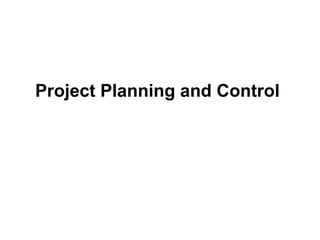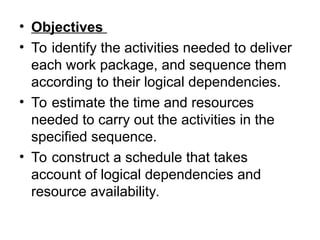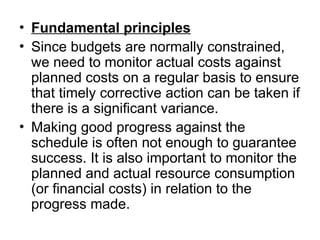Ad
Project Planning and control in Software Engineering
- 1. Project Planning and Control
- 2. • What is a project plan? • A project plan is a model of the process that the project team intends to follow to realize the project objectives. It brings together a number of important aspects of this process including its scope, timing, cost, and associated risks. • The project plan can be viewed as a type of “contract” between the project team members and other stakeholders. It defines” the process by which the objectives will be achieved, and the responsibilities in carrying out this process. • Project plans also underpin a number of other key project management functions including estimating and forecasting, options analysis and decision- making, and performance monitoring and control.
- 3. • Who is responsible for planning? • Everyone in the project team should be involved in developing the plan. It should be a collaborative effort. • The project manager should provide leadership in this area but may delegate some of the administrative aspects and detailed analysis to a project support role. • On larger projects there may be one or more dedicated planners.
- 4. • What are the benefits of planning? • It is more likely to lead to success and is more cost-effective than a “just do it” approach. • It develops greater mutual understanding and more commitment to achieving the objectives within the project team. • It provides an “early warning system” so that problems ” are identified while there is still time to do something about them.
- 5. • Key elements of a plan • Products – What products must the project deliver? What are the quality requirements associated with the products? • Activities – What activities are needed to deliver the products? • Resources – What resources are needed to carry out the activities? • Schedule – In what sequence should we carry out the activities? How long will the activities take to complete? Are the required resources available? How long will the project take overall?
- 6. • Budget – What are the time-phased resource requirements and financial costs? How much will the project cost overall? • Risks – Are we taking unnecessary risks? Is the level of risk – exposure commensurate with the risk appetite? Are there any opportunities that could be exploited? • Assumptions – What are the underlying assumptions associated with the plan?
- 7. • The planning process: • What is the process for developing a plan? • There are four key stages in developing a robust plan:
- 8. • STAGE 1 Identify, structure and define the products needed to achieve the project objectives. Break down the work needed to deliver the products into discrete work packages. Define the responsibilities of the individuals or teams who will deliver the work packages.
- 9. • STAGE 2 Identify the activities and resources needed to deliver the work packages. Construct a schedule that takes account of the logical dependencies between activities, and the availability of resources. • STAGE 3 Estimate the quantity of resources and financial costs associated with each work package, and use this information in conjunction with the schedule to develop time-phased budgets.
- 10. • STAGE 4 Identify and analyse the risks associated with each work package and evaluate a range of options for handling them. Select the most cost-effective combination of risk management actions and incorporate them into the plan.
- 11. • Stage 1 – Defining scope and responsibilities
- 12. • Objectives • To ensure that all the work and products needed to achieve the project objectives are included in the plan. • To develop a hierarchical framework for integrating the key planning and control functions (scope, quality, cost, time, risk) at different levels of management. • To specify the organisation and responsibilities for managing the work and delivering the products.
- 13. • Fundamental principles: • Break down the project work into cohesive work packages • Define the required results (i.e., the products) before considering how to achieve them. • Encourage collaborative planning and commitment to achieving results by negotiating and agreeing responsibilities at an early stage.
- 14. • Process description • Identify and structure the products needed to achieve the project objectives using a Product Breakdown Structure (PBS). Define the products and specify their purpose, quality requirements and acceptance criteria, using Product Descriptions (PD). • Break down the work needed to deliver the products into discrete work packages using a Work Breakdown Structure (WBS). Define the work packages and specify their products, quality requirements, acceptance criteria, assumptions, risks, and opportunities, using Work Package Descriptions (WPD). • Specify the organisation that will carry out and manage the work contained in the WBS, using an Organisational Breakdown Structure (OBS). Define the responsibilities of individuals or teams in the OBS (with respect to elements of the WBS) using a Responsibility Assignment Matrix (RAM).
- 15. • Stage 2 – Scheduling and time/resource analysis
- 16. • Objectives • To identify the activities needed to deliver each work package, and sequence them according to their logical dependencies. • To estimate the time and resources needed to carry out the activities in the specified sequence. • To construct a schedule that takes account of logical dependencies and resource availability.
- 17. • Fundamental principles: • The time and resources needed to complete each activity usually depend on the sequence in which the activities are carried out. • Since the time and resources needed to complete an activity are usually interdependent, it makes sense to estimate both of these at the same time. • Scheduling must take account of resource availability.
- 18. • Process description • Identify the activities needed to deliver each work package. Also identify any key events (milestones) associated with the delivery of products, important decisions, or external dependencies. Sequence the activities and milestones according to their logical dependencies, to create an activity network. • Estimate the time and resources needed to complete each activity and record the underlying assumptions as a Basis of Estimate (BoE). • Develop an initial schedule that takes account of the logical dependencies between activities. Calculate the Total Float for each activity and identify the Critical Path(s). If the initial schedule does not meet the required timescales then investigate alternative schedules or consider making tradeoffs. Analyse the time-phased resource requirements and, if necessary, adjust the schedule to take account of resource availability or to improve resource utilisation.
- 19. • Stage 3 – Cost estimating and budgeting
- 20. • Objectives • To develop a hierarchical framework for planning and controlling resource consumption and financial costs. • To estimate the quantities and financial costs of the resources needed to deliver each work package. • To develop time-phased budgets as a basis for performance monitoring and control.
- 21. • Fundamental principles • Since budgets are normally constrained, we need to monitor actual costs against planned costs on a regular basis to ensure that timely corrective action can be taken if there is a significant variance. • Making good progress against the schedule is often not enough to guarantee success. It is also important to monitor the planned and actual resource consumption (or financial costs) in relation to the progress made.
- 22. • Stage 4 – Risk analysis and response planning
- 23. • Objectives • To identify the risks associated with each work package. • To determine the overall risk exposure and the contribution of individual risks. • To prioritise risks for further management. • To develop cost-effective risk management actions (responses) and incorporate them into the plan.
- 24. • Fundamental principles: • Once the plan has been developed it should still be considered a draft until its risk content has been analysed. This analysis may lead to the plan being modified to include risk management actions. • Plans should be risk-efficient (i.e., should include no more risk than is necessary to provide a given level of “return”), and the risk exposure should be commensurate with the risk appetite.
- 27. • To inform decision-making processes at all levels in the organisation. • Apply the principles of closed-loop control to monitor project in the organisation, and to take any corrective action. To review the performance against the plan at regular intervals, and needed corrective actions to ensure that objectives are achieved. Take any corrective action needed to achieve the plan
- 28. • To identify problems and emergent risks early enough objectives while there is still time to do something about them. • Monitor trends in performance over a period of time as the project progresses • To communicate regular progress to the project team and other stakeholders as well as the “spot” performance with respect to an activity in order that confidence and baseline is maintained. This allows us to distinguish between commitment and reality and the focus towards the project is maintained
- 30. • Identify the objectives and constraints, and develop a plan. Review and baseline the plan. Obtain authorisation to proceed. • Do some work. • Measure performance and update the original estimates and forecasts. Update the schedule and budget forecasts to take account of the latest information. • Investigate the causes of any significant variations with respect to the baseline. Review the associated risks and assumptions. If necessary, develop options for taking corrective action. • Agree on any corrective action that is required and update the plans (via Change Control if the baseline is changed). • Confirm that the objectives have been achieved and that the required products have been delivered. • Obtain formal sign-off if appropriate.
- 31. Performance monitoring techniques • Schedule analysis – Monitor variations in the forecast schedule with respect to the baseline, as well as changes to the critical path(s) and remaining float of activities. • Budget analysis – Monitor variations in the forecast budget with respect to the baseline. • Milestone trend charts – Monitor the forecast dates and actual dates of key milestones as a function of time. • Earned Value Management (EVM) – Monitor “earned - value” and actual cost against planned value/cost • Risk analysis –Monitor confidence values or probability distributions associated with key elements of the schedule or budget, as a function of time. • Buffer management “fever charts” – Monitor the consumption of schedule and budget contingency buffers as a function of time.
- 32. • Techniques for planning larger projects • Staged planning – The project is split into a number of discrete stages. An outline plan is developed for the project as a whole, together with more detailed plans for each stage. The plans for each stage are usually developed towards the end of the preceding stage. This approach is a useful way of limiting risk exposure when there is uncertainty about the requirements, the work to be performed, the available resources, or the project environment. • Hierarchical planning – Planning and control is carried out in a hierarchical fashion so that lower level plans and their associated control systems are nested within elements of the higher-level plans. • Rolling Wave planning – Only the near-term work packages are planned in detail, while the far-term work packages (sometimes called Planning Packages) are planned in outline only.
- 33. • Principles of effective planning and control • Divide-and-conquer – Manage complexity by breaking down the various elements of the plan in a structured way. But don’t forget to keep track of the dependencies between elements as you go. • Integrated approach – Don’t plan and control the various project functions in isolation (e.g., scope, quality, cost, time, risk), as they are all interdependent. Instead, adopt a more integrated approach by bringing them together at key control points on the WBS (e.g., work packages or control accounts). • Keep it simple, systematically – Only add more detail to the plan where the cost of doing so and the increased complexity it brings with it is justified by the amount of information it provides. • Team collaboration – Don’t forget that the plan represents the team’s vision for achieving the objectives. So make sure they are involved in its development and any subsequent changes during the monitoring and control process.
- 34. RECAP • Activity – A task, operation, or process consuming time and possibly other resources. • Baseline – A snapshot of a plan (or element of a plan) that is used as a point of reference. • Budget – The agreed cost or quantification of resources needed to complete an activity by a set time. • Critical Path – A sequence of activities through an activity network where each activity in the sequence has zero or negative total float. • Duration – The estimated or actual time required to complete an activity. • Milestone – A key event selected for its importance in the project. • Product – The measurable output of an activity. • Resource – Anything other than time that is necessary for carrying out an activity.



























































































